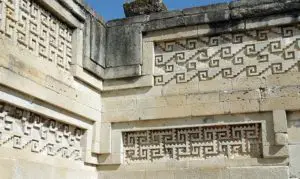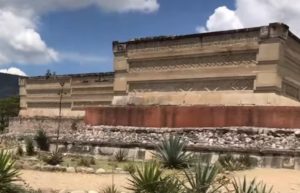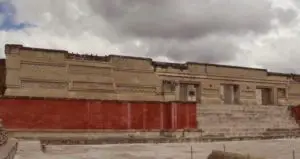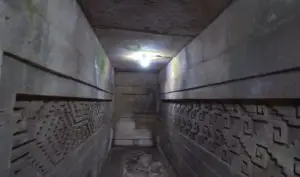Podcast: Play in new window | Download
Subscribe: Apple Podcasts | RSS
 Francisco de Burgoa was a typical scholarly Dominican friar of his times. Born in the year 1600 in Oaxaca, then part of New Spain, the human aspect of his surrounding native land had always fascinated him. As the curate of several indigenous parishes in Oaxaca, Burgoa learned several native languages including Mixtec and Zapotec. The curious friar lived 100 years after the Spanish conquest of the Valley of Oaxaca and felt the need to capture the fading history and culture of the peoples of the land. Francisco de Burgoa would leave behind volumes of books – more like complete encyclopedias – detailing the accounts of what happened in this place and what the people were like before the Europeans arrived. He interviewed many elders and also relied upon the works of other religious men and lay people who had close contact with the indigenous of Oaxaca at the time of first contact and in the years immediately after. One place that fascinated Burgos was the ruined city of Mitla which in his time had functioning colonial churches built on top of much older Mixtec and Zapotec structures. In his exploration of the history of this site, Brother Francisco was fascinated by the account of the Vuijatao, the ruler of the city who served in a role that was like that of the Catholic pope and part Oracle of Delphi. The Vuijatao was a prophet, judge and medium and held an amount of political and religious authority unique in Mesoamerica. Not only did the locals revere and obey him, but nobility from other ancient Mexican cultures, including the faraway royal family of the Aztecs, respected his power and sought his counsel and favors. Burgoa realized that Mitla played a very important part in the history of the land of his birth going back thousands of years, having a profound impact on many cultures and across vast distances.
Francisco de Burgoa was a typical scholarly Dominican friar of his times. Born in the year 1600 in Oaxaca, then part of New Spain, the human aspect of his surrounding native land had always fascinated him. As the curate of several indigenous parishes in Oaxaca, Burgoa learned several native languages including Mixtec and Zapotec. The curious friar lived 100 years after the Spanish conquest of the Valley of Oaxaca and felt the need to capture the fading history and culture of the peoples of the land. Francisco de Burgoa would leave behind volumes of books – more like complete encyclopedias – detailing the accounts of what happened in this place and what the people were like before the Europeans arrived. He interviewed many elders and also relied upon the works of other religious men and lay people who had close contact with the indigenous of Oaxaca at the time of first contact and in the years immediately after. One place that fascinated Burgos was the ruined city of Mitla which in his time had functioning colonial churches built on top of much older Mixtec and Zapotec structures. In his exploration of the history of this site, Brother Francisco was fascinated by the account of the Vuijatao, the ruler of the city who served in a role that was like that of the Catholic pope and part Oracle of Delphi. The Vuijatao was a prophet, judge and medium and held an amount of political and religious authority unique in Mesoamerica. Not only did the locals revere and obey him, but nobility from other ancient Mexican cultures, including the faraway royal family of the Aztecs, respected his power and sought his counsel and favors. Burgoa realized that Mitla played a very important part in the history of the land of his birth going back thousands of years, having a profound impact on many cultures and across vast distances.
 Designated a World Heritage Site by the United Nations Educational Scientific and Cultural Organization in 2010, archaeologists believe that people may have been living at the site of the modern-day ruins of Mitla since 900 BC. Located in one of the central valleys of Oaxaca called the Tlacolula Valley, Mitla lies 24 miles to the southeast of Oaxaca City. Although situated in a valley, the site’s elevation is still high at 4,855 feet, and it is in a somewhat dry and cold zone, which has helped to preserve some aspects of the site. The Zapotecs arrived in the Tlacolula Valley around 1000 BC and it was that group of people who founded the small village at the ruin’s current location a few generations after their arrival. The Zapotecs called the city Lyobaa, which translated to English means “place of rest.” By the year 750 AD Mitla had grown from a simple fortified town to the most important city in the Zapotec state. Most of the monumental architecture still visible today was either finished or got its start during the time after 750 AD. By 850 AD Mitla had turned into the political and religious center for the region. After nearly two thousand years of Zapotec occupation of the site, by the year 1000 AD, the Mixtecs took control of the central valleys of Oaxaca and conquered the stone city of Mitla. The Zapotecs were not pushed out; rather, both the Zapotecs and their new overlords, the Mixtecs, blended to a great degree. In a few centuries a new type of Mixtec culture emerged. Art and architectural historians can trace the mixing of art and building styles, which reached their height at around 1200 AD at Mitla. By this time the city had been known as a gateway between the living world and the dead world, and many elites throughout ancient Mexico made pilgrimages to the site and were often buried there. Although the Tlacolula Valley is somewhat isolated, there was a great deal of interest in the city from all parts of Mesoamerica which made Mitla somewhat cosmopolitan in its feel. By the time the Aztecs took control of central Mexico in the mid-1300s, this city had already appeared on the radar of many central Mexicans. Many people made the 250-mile journey from the Aztec capital of Tenochtitlán to Mitla, and over the years, Aztec interest in the area intensified. Between the years 1497 and 1502 during the reign of Aztec Emperor Ahuizotl, the Aztec Empire conquered the central valleys of Oaxaca. As Mitla was in the far eastern section of these valleys and because the city had such great significance, the Aztecs gave Mitla a generous amount of autonomy or self-rule. The Aztecs renamed the city from Lyobaa to Mictlán at this time. In the language
Designated a World Heritage Site by the United Nations Educational Scientific and Cultural Organization in 2010, archaeologists believe that people may have been living at the site of the modern-day ruins of Mitla since 900 BC. Located in one of the central valleys of Oaxaca called the Tlacolula Valley, Mitla lies 24 miles to the southeast of Oaxaca City. Although situated in a valley, the site’s elevation is still high at 4,855 feet, and it is in a somewhat dry and cold zone, which has helped to preserve some aspects of the site. The Zapotecs arrived in the Tlacolula Valley around 1000 BC and it was that group of people who founded the small village at the ruin’s current location a few generations after their arrival. The Zapotecs called the city Lyobaa, which translated to English means “place of rest.” By the year 750 AD Mitla had grown from a simple fortified town to the most important city in the Zapotec state. Most of the monumental architecture still visible today was either finished or got its start during the time after 750 AD. By 850 AD Mitla had turned into the political and religious center for the region. After nearly two thousand years of Zapotec occupation of the site, by the year 1000 AD, the Mixtecs took control of the central valleys of Oaxaca and conquered the stone city of Mitla. The Zapotecs were not pushed out; rather, both the Zapotecs and their new overlords, the Mixtecs, blended to a great degree. In a few centuries a new type of Mixtec culture emerged. Art and architectural historians can trace the mixing of art and building styles, which reached their height at around 1200 AD at Mitla. By this time the city had been known as a gateway between the living world and the dead world, and many elites throughout ancient Mexico made pilgrimages to the site and were often buried there. Although the Tlacolula Valley is somewhat isolated, there was a great deal of interest in the city from all parts of Mesoamerica which made Mitla somewhat cosmopolitan in its feel. By the time the Aztecs took control of central Mexico in the mid-1300s, this city had already appeared on the radar of many central Mexicans. Many people made the 250-mile journey from the Aztec capital of Tenochtitlán to Mitla, and over the years, Aztec interest in the area intensified. Between the years 1497 and 1502 during the reign of Aztec Emperor Ahuizotl, the Aztec Empire conquered the central valleys of Oaxaca. As Mitla was in the far eastern section of these valleys and because the city had such great significance, the Aztecs gave Mitla a generous amount of autonomy or self-rule. The Aztecs renamed the city from Lyobaa to Mictlán at this time. In the language  of the Aztecs, Nahuatl, “Mictlán,” literally means “place of the dead.” “Mictlán” directly refers to the Aztec religion’s 9-leveled place of the afterlife where the god Mictlantecuhtli lived peacefully in a house with no windows along with his wife Mictecacihuatl. For more information about the Aztec god Mictlantecuhtli, please see Mexico Unexplained episode number 170 https://mexicounexplained.com/mictlantecuhtli-aztec-god-of-death/ After the Aztec Empire collapsed in August of 1521 the central valleys of Oaxaca found themselves in a sort of political limbo, but that did not last for long. In just a few short months – by November 25, 1521 – the Spanish conquistador Francisco de Oruzco arrived in the Oaxaca Valley to claim the region for Hernán Cortés, the legendary conqueror of the Aztecs. The King of Spain would later grant the central valleys of Oaxaca to Cortés as a prize for toppling the Aztec Empire, giving the conquistador the title of Marquess of the Valley of Oaxaca. Immediately thereafter Mitla came under the direct control of Cortés and became an integral part of the Spanish Empire. The first Catholic priests to the site were somewhat shocked by the city’s focus on death. Upon visiting Mitla in the late 1520s, Friar Toribio de Benevente, wrote in his diaries and correspondence that the name of the city meant “Hell.” The Spanish religious authorities were somewhat appalled by the indigenous beliefs and customs regarding the afterlife throughout ancient Mexico. In the year 1561, Archbishop of Oaxaca Bernardo de Albuquerque saw fit to destroy Mitla and exile most of its inhabitants, specifically the indigenous religious practitioners. The archbishop directed that a church dedicated to San Pablo be built on the top of the old Zapotec temple called the Yohopàe. The word Yohopàe translates to “house of the vital force” and had been a place of holy worship and great rituals at Mitla for some 1,500 years. The bishop later wrote in his memoirs that he had the church of San Pablo built there to “keep the devil from escaping” from underneath the native sacred site and to impress upon the local people the power of their new overlords. Many of the stones from the great Yohopàe and other buildings at Mitla were carted away to be used in the construction of other churches throughout Oaxaca. Catholic clergy took up residence on the old temple grounds much like the Zapotec and Mixtec priests of old. By the time the Dominican friar Francisco de Burgoa arrived to Mitla in the early part of the 1600s, as mentioned earlier, the site was only a fragment of its former glory.
of the Aztecs, Nahuatl, “Mictlán,” literally means “place of the dead.” “Mictlán” directly refers to the Aztec religion’s 9-leveled place of the afterlife where the god Mictlantecuhtli lived peacefully in a house with no windows along with his wife Mictecacihuatl. For more information about the Aztec god Mictlantecuhtli, please see Mexico Unexplained episode number 170 https://mexicounexplained.com/mictlantecuhtli-aztec-god-of-death/ After the Aztec Empire collapsed in August of 1521 the central valleys of Oaxaca found themselves in a sort of political limbo, but that did not last for long. In just a few short months – by November 25, 1521 – the Spanish conquistador Francisco de Oruzco arrived in the Oaxaca Valley to claim the region for Hernán Cortés, the legendary conqueror of the Aztecs. The King of Spain would later grant the central valleys of Oaxaca to Cortés as a prize for toppling the Aztec Empire, giving the conquistador the title of Marquess of the Valley of Oaxaca. Immediately thereafter Mitla came under the direct control of Cortés and became an integral part of the Spanish Empire. The first Catholic priests to the site were somewhat shocked by the city’s focus on death. Upon visiting Mitla in the late 1520s, Friar Toribio de Benevente, wrote in his diaries and correspondence that the name of the city meant “Hell.” The Spanish religious authorities were somewhat appalled by the indigenous beliefs and customs regarding the afterlife throughout ancient Mexico. In the year 1561, Archbishop of Oaxaca Bernardo de Albuquerque saw fit to destroy Mitla and exile most of its inhabitants, specifically the indigenous religious practitioners. The archbishop directed that a church dedicated to San Pablo be built on the top of the old Zapotec temple called the Yohopàe. The word Yohopàe translates to “house of the vital force” and had been a place of holy worship and great rituals at Mitla for some 1,500 years. The bishop later wrote in his memoirs that he had the church of San Pablo built there to “keep the devil from escaping” from underneath the native sacred site and to impress upon the local people the power of their new overlords. Many of the stones from the great Yohopàe and other buildings at Mitla were carted away to be used in the construction of other churches throughout Oaxaca. Catholic clergy took up residence on the old temple grounds much like the Zapotec and Mixtec priests of old. By the time the Dominican friar Francisco de Burgoa arrived to Mitla in the early part of the 1600s, as mentioned earlier, the site was only a fragment of its former glory.
So, what does the current archaeological site of Mitla look like and how is it important in the context of ancient Mexico? Above all else, no other site in ancient Mexico has the elaborate monumental decoration found at Mitla. Unique at this city, intricate interlaced and interlocked designs comprised of small, finely cut and polished stone pieces that have been fitted together without the use of mortar cover tombs, panels and entire walls at this complex. Mitla showcases the ultimate refinement of ancient Zapotec decoration, and while some instances of this beautiful craftsmanship can be found at other sites, nothing compares to the extravagance of design found at Mitla.
 The site is divided into five groups based on clusters of buildings: The South, the Adobe, the Arroyo, the Columns or Palace, and the Church or North Group. Restoration at the site in anticipation of opening it up to tourists began in the early 1980s, and the entrance to the archaeological park of Mitla is at the North Group, dominated by the 16th Century church of San Pablo. The former Zapotec temple once faced a large courtyard that still exists today. The walls that remain contain some very interesting murals which were thought to be part of the quarters of priests or other holy dignitaries. Some columns of this structure also still stand and there are many tombs under the surface of the structures of the North Group. Open to tourists, the visitor must crawl on his or her knees to access the ample subterranean rooms that are elaborately decorated in typical Mitla style. South of the Church or North Group is the Columns Group, also called the Palace Group. Here some of the most detailed geometric designs in all ancient Mexico can be found gracing the walls of the main building called The Palace or The Grand Hall of the Columns. In the north and east parts of this massive building members of the Zapotec nobility and priestly class were buried in elegant tombs that were finely decorated. Here we see the important role Mitla played in the religious life of various cultures throughout ancient Mexico. On the west wall we see the Central Mexican creation saga of the Toltec as told by the Aztecs. The Mixtec creation story is on the east wall, and the founding of Mitla by Zapotec priests is illustrated on the north wall. A fourth painting, portraying the creation of the ancient Zapotec state by the ancestors from Monte Albán, is now largely destroyed but its faint remnants exist on the south wall.
The site is divided into five groups based on clusters of buildings: The South, the Adobe, the Arroyo, the Columns or Palace, and the Church or North Group. Restoration at the site in anticipation of opening it up to tourists began in the early 1980s, and the entrance to the archaeological park of Mitla is at the North Group, dominated by the 16th Century church of San Pablo. The former Zapotec temple once faced a large courtyard that still exists today. The walls that remain contain some very interesting murals which were thought to be part of the quarters of priests or other holy dignitaries. Some columns of this structure also still stand and there are many tombs under the surface of the structures of the North Group. Open to tourists, the visitor must crawl on his or her knees to access the ample subterranean rooms that are elaborately decorated in typical Mitla style. South of the Church or North Group is the Columns Group, also called the Palace Group. Here some of the most detailed geometric designs in all ancient Mexico can be found gracing the walls of the main building called The Palace or The Grand Hall of the Columns. In the north and east parts of this massive building members of the Zapotec nobility and priestly class were buried in elegant tombs that were finely decorated. Here we see the important role Mitla played in the religious life of various cultures throughout ancient Mexico. On the west wall we see the Central Mexican creation saga of the Toltec as told by the Aztecs. The Mixtec creation story is on the east wall, and the founding of Mitla by Zapotec priests is illustrated on the north wall. A fourth painting, portraying the creation of the ancient Zapotec state by the ancestors from Monte Albán, is now largely destroyed but its faint remnants exist on the south wall.
Unlike many ancient ruined cities in Mexico, most of Mitla has been explored and excavated. There are several challenges that Mitla faces in the 21st Century, however. The site is right up against the modern-day town of San Pablo Villa de Mitla. Shantytown buildings butt up against ancient walls and some people still cannibalize ancient structures illegally to get quick and free building materials. For some strange reason, the site has been the target of modern graffiti vandals who feel the need to tag the fifteen-hundred-year-old monuments. The biggest challenge is the elements, however, and perhaps time itself. As with many other ancient places it is a race against the clock to preserve the unique heritage found at this special place. With many people working on preservation and conservation at Mitla, this unique and important site will likely continue to dazzle visitors for generations to come.
REFERENCES
INAH Website
Wikipedia
